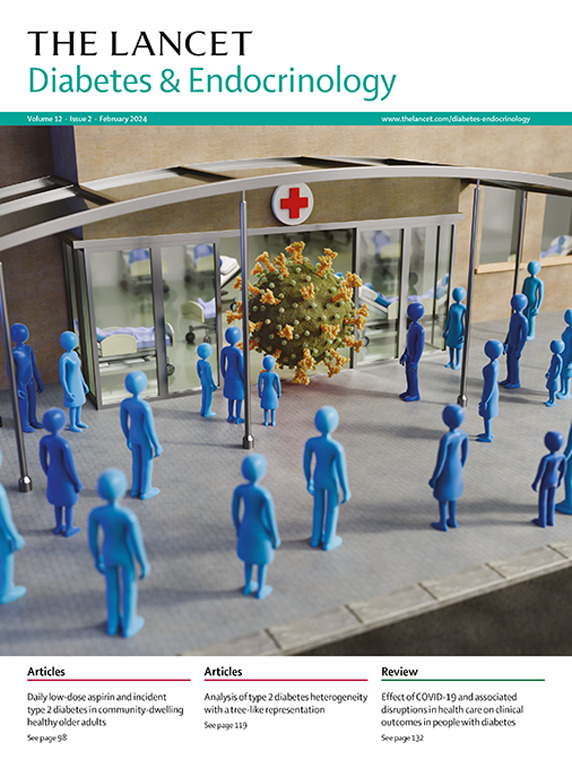恩格列净对常规和探索性急慢性肾脏结局的影响:个体参与者水平的荟萃分析
IF 41.8
1区 医学
Q1 ENDOCRINOLOGY & METABOLISM
引用次数: 0
摘要
背景:钠-葡萄糖共转运蛋白-2 (SGLT2)抑制对缓慢进展的慢性肾病患者(如低蛋白尿)和有急性肾小球滤过率(eGFR)大幅下降风险的患者开始此类治疗时肾脏结局的影响仍不确定。我们的目的是探讨恩格列净对这些人群亚型的一系列肾脏结局的影响。方法在这项荟萃分析中,我们使用了来自4个大型安慰剂对照试验(EMPA-REG OUTCOME、emperr - reduced、emperr - preserved和EMPA-KIDNEY)的23340名参与者的个体水平数据来评估恩格列净对常规和探索性急慢性肾脏结局的影响。然后,我们通过异质性和趋势测试,评估急性eGFR下降对治疗开始或其他关键人群亚型的影响是否随预测大小而变化。从勃林格殷格翰公司(殷格翰,德国)获得了个人层面的数据。与安慰剂相比,分配恩格列净可使急性肾损伤标志物(连续随访样本中血清肌酐升高≥50%)的风险降低20%(风险比0.80 [95% CI 0.72 - 0.88]; 1573个结局),急性肾损伤不良事件发生率降低27%(0.73[0.63 - 0.85];694个结局),慢性肾脏疾病分类进展结局发生率降低30%(0.70[0.63 - 0.78];1403个结局),肾功能衰竭发生率降低34%(0.66[0.55 - 0.79];490个结局)。恩帕列净将慢性年eGFR下降率降低了64% (95% CI 59-69),治疗后无下降斜率(10630名参与者的随机化和治疗后eGFR值的随机结局)降低了64%(54-73)。这些肾脏益处在按急性eGFR下降预测大小划分的亚组中是相似的,并且与糖尿病或心力衰竭状态、肾功能水平或蛋白尿无关。sglt2抑制降低了急性和慢性肾脏结局的风险,与eGFR急性下降的大小无关。与糖尿病状况、心力衰竭状况、肾脏疾病的主要原因以及这些疾病的严重程度标志无关,对肾脏的益处是显而易见的。本文章由计算机程序翻译,如有差异,请以英文原文为准。
Effects of empagliflozin on conventional and exploratory acute and chronic kidney outcomes: an individual participant-level meta-analysis
Background
Uncertainty remains about effects of sodium–glucose co-transporter-2 (SGLT2) inhibition on kidney outcomes in individuals with slowly progressive chronic kidney disease (eg, low albuminuria) and those at risk of large acute estimated glomerular filtration rate (eGFR) dips on initiation of such treatment. We aimed to explore the effects of empagliflozin on a range of kidney outcomes in these population subtypes.Methods
In this meta-analysis, we used individual-level data from 23 340 participants in four large placebo-controlled trials (EMPA-REG OUTCOME, EMPEROR-Reduced, EMPEROR-Preserved, and EMPA-KIDNEY) to assess the effects of empagliflozin on conventional and exploratory acute and chronic kidney outcomes. We then assessed whether effects varied by predicted size of the acute eGFR dip on treatment initiation or among other key population subtypes using tests for heterogeneity and trend. The individual-level data were requested from Boehringer Ingelheim (Ingelheim, Germany).Findings
Compared with placebo, allocation to empagliflozin reduced the risk of a marker of acute kidney injury (a ≥50% increase in serum creatinine in consecutive follow-up samples) by 20% (hazard ratio 0·80 [95% CI 0·72–0·88]; 1573 outcomes), acute kidney injury adverse events by 27% (0·73 [0·63–0·85]; 694 outcomes), a categorical chronic kidney disease progression outcome by 30% (0·70 [0·63–0·78]; 1403 outcomes), and kidney failure by 34% (0·66 [0·55–0·79]; 490 outcomes). Empagliflozin slowed a chronic annual rate of eGFR decline by 64% (95% CI 59–69) and off-treatment dip-free slope—a post-hoc outcome using randomisation and off-treatment eGFR values available in a subset of 10 630 participants—by 64% (54–73). These kidney benefits were similar in subgroups divided by predicted size of acute eGFR dip, and were present irrespective of diabetes or heart failure status, level of kidney function, or albuminuria.Interpretation
SGLT2 inhibition reduces risk of acute and chronic kidney outcomes irrespective of the size of the acute dip in eGFR. Kidney benefits are evident irrespective of diabetes status, heart failure status, primary cause of kidney disease, and markers of severity of these diseases.Funding
None.求助全文
通过发布文献求助,成功后即可免费获取论文全文。
去求助
来源期刊

The Lancet Diabetes & Endocrinology
ENDOCRINOLOGY & METABOLISM-
CiteScore
61.50
自引率
1.60%
发文量
371
期刊介绍:
The Lancet Diabetes & Endocrinology, an independent journal with a global perspective and strong clinical focus, features original clinical research, expert reviews, news, and opinion pieces in each monthly issue. Covering topics like diabetes, obesity, nutrition, and more, the journal provides insights into clinical advances and practice-changing research worldwide. It welcomes original research advocating change or shedding light on clinical practice, as well as informative reviews on related topics, especially those with global health importance and relevance to low-income and middle-income countries. The journal publishes various content types, including Articles, Reviews, Comments, Correspondence, Health Policy, and Personal Views, along with Series and Commissions aiming to drive positive change in clinical practice and health policy in diabetes and endocrinology.
 求助内容:
求助内容: 应助结果提醒方式:
应助结果提醒方式:


